What is The Berber Carpet?
The Berbers have lived in Morocco for more than three millennia, the Berber carpet also called Berber rugs is iconic in Berber culture, those carpets are handmade in Morocco by Berber Women, the patterns and their meanings are part of a the berber tradition.
History of the traditional Berber carpet
The origins of the Berber carpet is in the Atlas Mountains of Morocco, the Berbers used different techniques from those used for the Oriental or the Persian rugs.
If you compare the patterns of the Berber carpet to signs in cave arts and artefacts of the primitive cultures of the human race, you will find the same signs and forms used and you will discover surprising similarities and connections that you can also trace to the upper-Palaeolithic period in Europe, the Neolithic period in the Orient and in the Mediterranean basin.This is why the Berber carpet can be considered as the last token of the archaic world.
The abstract and geometric language of the Berber carpet comes from the origins of the body, the shape and the functions of the human sexual organs. Based on the duality and the relationship of men and women, it became the expression of universal fertility including all of nature. The carpet is an artistic creation of the Berber woman and reflects above all the phases of her life, her sexual timeline and experience: as a virgin, a new bride, through the marriage, pregnancy and delivery. During the 12th and 13th centuries, Morocco was already known for the beauty of its carpets, wall carpets and its wall hangings (‘hanbel’).
During the middle Ages, the carpet was one of the presents for foreign Embassies or used in the princely caravan where beautiful silk fabrics with gold thread and carpets ‘zarabi’ were on camels. Among the different meanings of ‘zarabi’ (carpet) coming from Arabic, we can especially keep ‘flowerbed’ and ‘what is lying on the floor and on where we lean against’. The Berber word for it is ‘tazerbyt’. In Morocco, we can also use the word ‘gtifa’ coming from the same origin, which is the name of the wool carpets often knitted in the high altitude region, Marmoucha or the AitOuaouzguite for example.
During the 16th century, Jean Leon L’Africain (Al-HasanibnMuhammed) explained that the carpet was one of the presents for Fez brides: ‘We still give a wool carpet of about twenty cubits and three covers which one side is a sheet’. Carpets were also sold at Fez auctions and exported especially to Black Africa. They were famous for their fineness on the majestic goubba (cupola in Arabic), which were wash centres for believers going to the mosque.
The oldest preserved carpet in Morocco dates back to the 18th century: the Chiadma one for example, which is dated exactly (1202/1787 AC).
The perfect present
The carpet is a perfect present and during the 19th century the Moroccan carpet was one of the most exported products to Europe. They could be found a lot in France during the universal exhibitions of 1867, 1878 and 1889. At the end of the 19th century and at the beginning of the 20th century, the weaving of carpet was a very important activity in almost every city in Morocco.
The ‘Berber carpet’ or ‘Carpet of tribes’
The carpet is an art item based on the knowledge of an ancient civilization of people, which expressed their History, their knowledge thanks to decorative ways and expressions of art, sculptures, poems, drawings, colours etc.
So the carpet is an art object made in families with high pastoral traditions and these families subsist primarily on farming and agriculture, in other words they are rural families. The manufacturing of traditional carpets requires some conditions, basic modes and equipment such as:
- Pure and good wool as raw materials, which will be transformed as threads of different dimensions, varied properties and natural tints.
- Appropriate equipments (weaving loom) of different shapes depending on the use.
- Relevant staff, which masters the traditional methods of weaving and decorative patterns.
The weaving of carpet is an essential activity in some social standing because it plays a primordial economic role for the subsistence of families. It’s also a traditional commercial mode based on barter. Most of the carpet manufacturers are villagers from the Atlas mountains. In households, the man and the woman work together. The woman deals with the weaving and modelling of the carpets and the husband deals with the commercialization at the markets, which enables them to buy food and other products they need to live.
From an artistic point of view, the best carpet is still produced in some Berber regions and it is made from local natural products (tints). The tribes use decorative patterns to express their culture and their origins. These patterns relate the spirit of cohabitation, which always existed in these tribes according to ancient stories with people from different convictions and different civilizations (Muslim, Jewish, Berber, and Christian).
The master of weaving carpets is transmitted from mother to daughter. This way it creates a learning tradition in rural social standings.
Different types of Berber carpet
The Ait-Ouaouzguite carpet
The Ait-Ouaouzguite carpet from the tribe of the Taznakhet region is the carpet of the High Atlas region with well-worked sheep wool, bright colours and well-organized geometric patterns.
The Berber’s tradition carpets are the most important category and the more representative of the Moroccan carpet in the world (with the Rbati Carpets made in the Capital of Morocco - Rabat). It is a typical production of the Atlas region with outstanding decorations and patterns peculiar to each tribe. We can separate them like this:
The Middle Atlas carpets (Meknes’ Rabat region), tribe Zemmour, Zaer, Zain, Bani, Mtir, AitSgougou, BeniMguil
You can find most of the weaver tribes in the Middle Atlas region. Their carpets are famous for their white and silky velvet. The knots sometimes reach 10cm high or more. These carpets are used as mattress, covers and have simple decoration with diamond-shapes. They are called ‘achdif’. The middle Atlas’ carpets are weaved with methods, which are a bit different depending on the tribes.
Middle Atlas carpet (Fez region): The tribes of BeniOuarain ¤ AitIghezzrane - BeniAlaham- AitHalli ¤ Aityoussi ¤ AitSeghrouch’ne- Marmoucha - AitYoub ¤ AitIzdeg – AitYa’coub
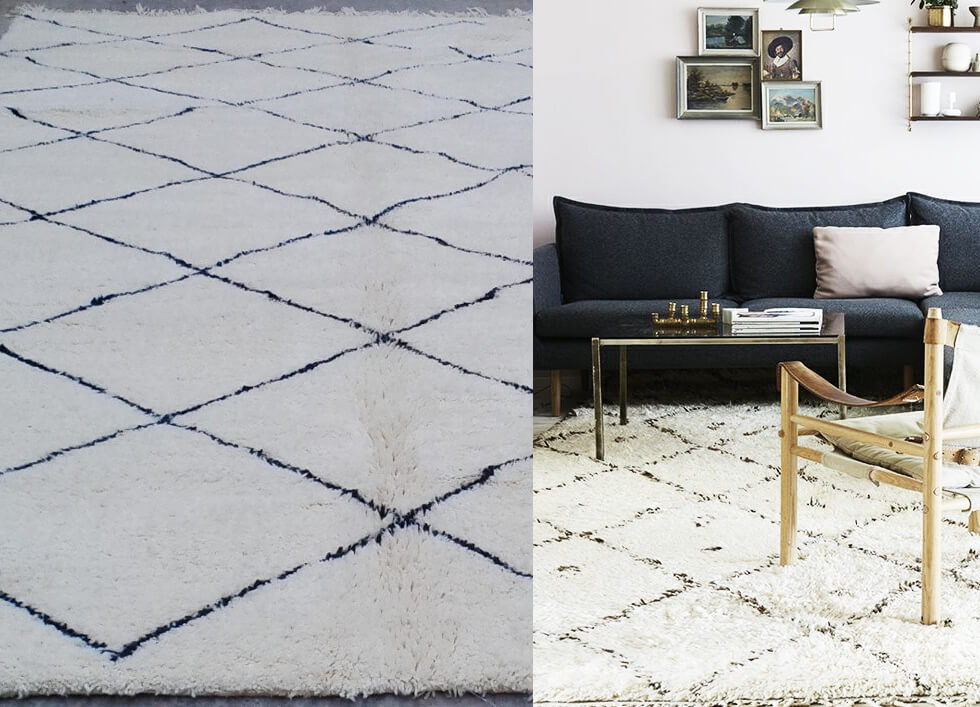
Beni-ouarain berber carpet
The BeniOuarain carpet from the Middle Atlas region is traditionally weaved into a big white carpet with brown drawings on it. Thick, it can keep heat and is more comfortable.
The High Atlas carpet
They are weaved according to the same mode as the city carpet. They are also called the Ait Ouaouzguite carpets, which is the name of a tribe living between Ouarzazate and Taznakht.
The Glaoua carpets from High Atlas combine three techniques of textile realization: knotted points, tapestry and weaving at a flat level structure in symmetric windows. The handmade models are weaved and knotted. It represents a unique style because it combines all the arts of weaving: it is weaved, knotted and embroidered. The Berbers stretch threads at each side, double them up and then knot them together to create a bag for their trip. The wool colour is natural.
Haouz carpet from Marrakech
It is a rural carpet. The knotting carpet tribes around Marrakech are almost all from Arabic origin (Rehamma carpet, H’mar carpet, OuladesBouseba carpet). The High Atlas carpets are different in sizes, colours and patterns.
There are 4 categories of quality, classified officially by colours: standard (green), average - medium (yellow), high (blue) and extra high (orange).
Techniques of carpets manufacture
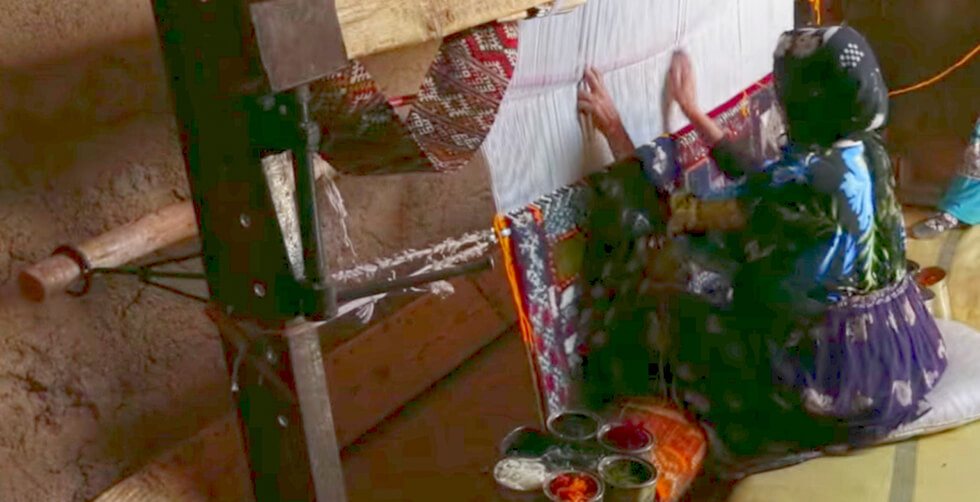
Handmade Berber carpet
Nowadays, in some region of Morocco, the wool is considered as God sent. People say it can protect one from evil forces. From the cut to the weaving, the wool is treated carefully and worked according to a very precise ritual transmitted from generation to generation. Then, after the cut, the wool is kept in a discreet room of the house. When they wash the wool in the river, the weavers say: ‘The wool as the wheat creates abundance’. About the dye, which will change the aspect of the wool without changing its thermal insulator, resistance, and comfort, the wool is worked according to precise rituals again. The day before the dye, they exhibit the baths at the glow of stars to get rid of its evil capacities.
The weaver fumigates the wool ready to be dyed, hides it and purifies herself as if she prepares herself to pray. The day after, at dawn, she returns to the bath that she exhibited to the stars without turning around. Then she begins the dye after pronouncing a prayer, the ‘Basmala’. For the weaving, the weaver asks for help from two neighbours to put up her weaving loom. After they are hammered into the ground two stakes, the owner of the weaving loom says the ‘Basmala’ and then smashes some sugar pieces between the two stakes. Then, the three weavers sing the following sentences: ‘We want to put up the weaving loom, each weaving loom, which see the light of day should be finished’.
In some Atlas tribes, when a woman sells or buys a carpet (which is created during more than one year) the event is perceived as a god sent a good omen and leads to a great celebration. On the other hand, in some other tribes, the end of the weaving is considered as a loss of a child we knew and raised. The end of the weaving comes with cries and tears. The technique of weaving spread fast through the 'douars', villages and beyond. To have a thread of wool between 3 and 5cm each, women coil a thread very tight and regularly on a stick they have cut. Around two threads of chain, they pass each thread on and form the decorative knots.
Prices of the Berber carpets
The best way to buy an authentic carpet is to visit Morocco and go to the Atlas Mountains where you can have different carpet choices and buy directly from the producer. It is clearly the right choice to bypass the large broadcasters and distributors to have an authentic carpet at a better price.
The price depends on the quality of the carpet and the transport cost of each carpet, be aware that it isn't easy to find an authentic Berber carpet, for example Beni Ouarain carpets are sometimes made by other tribes and their quality is not matching the originals (price may vary from 300$ to 700$).In USA and Europe you can find some carpet stores and retailers who sell 'Moroccan carpets' for home use, be aware that those carpets could be from industry made by nylon and synthetic fiber they aren't environmentally friendly, are not durable carpets and aren't handmade in Morocco.
Colours and Patterns of the Berber carpet
Each Berber tribe have its own carpet pattern and style, The carpets of Beni Ouarain tribe is minimalist with only black diamond forms and a white background, while the carpets of Azilal are very colourful and artistic, the carpets of Beni M'guild tribe are coloured with one main colour (orange, pink or blue). You can also find other tribes each one has its own style like the Boucherouite, Boujad, Talsint, Zaiane ...
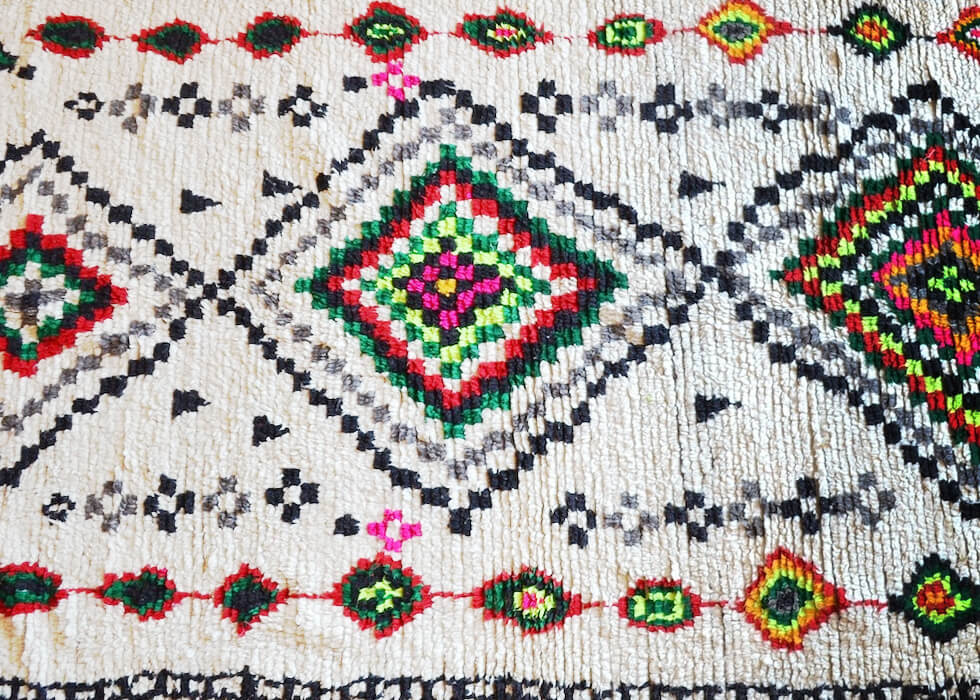
Pattern of the berber carpet - From the region of Azilal
In Morocco and in the High Atlas region, weaving has an unquestionable symbol. The geometric patterns and their combinations are sensed only by the one who produces it. You can find connections between women tattoos and the patterns painted or carved on the potteries and the carpets. Sometimes it is used to identify pets.
The stylized shapes that the weaver draws is part of her culture (way, river, stars, beetle, scorpions, flowers, mirror, cake etc).
The teapot in profile often in the middle of the carpet is full of sense and refers to hospitality and conviviality beloved by the inhabitants. We find also other shapes, such as diamond-shaped, broken lines, checked, herringbone, cross, slanted or straight spacers, combs and stars.
Meaning of these patterns
Represented alone, the diamond-shape is sometimes seen as the eye, which protects against bad luck. Butterflies represented with two triangles but also flowers and stars represent the feminine beauty. A zigzag line often surrounds the carpet and represents rivers, snakes or family. Branch express difficulty, danger but also vegetables and the tree of life. The comb refers to the weaving. The woman, free, with opened feet and arms up is represented with a sign of tifinagh alphabet.
The partridge leg, the Fatma hand and the bride belt are often represented.
The Berber cross, often in the middle of the carpet echoes the Kasbah architecture.
Dimension of a Berber Carpet
Longitude can vary between 2m up to 6m while the width is almost between 1.9m to 2.5m.
How to clean a Berber carpet?
Berber carpet have an inherent resilience, they are quiet and comfortable to foot traffic and easy to maintain and keep clean: you can easily clean a Berber carpet by yourself, from time to time use the vacuum cleaner to remove dust, If some tough stains or deep-down grime remains then the best way to clean it is to use a mix of water with soap (five parts to one) and apply with a sponge then let it dry in the sun for one day or two, you could also use a steam cleaner if you find it is hard to clean or if it is really dirty. If steam cleaning isn't enough it maybe a good idea to contact a professional carpet cleaner.
Share your experiences with our community.
Related articles : Culture
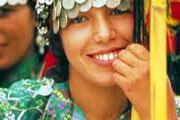 Traditional Clothing
Traditional Clothing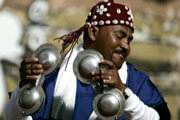 Music of Morocco
Music of Morocco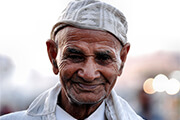 Moroccan Proverbs and Quotes
Moroccan Proverbs and Quotes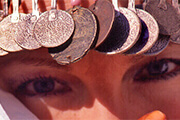 Moroccan People
Moroccan People Moroccan Architecture
Moroccan Architecture
Advertisement